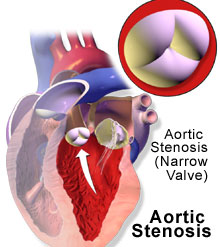Aortic Stenosis - Symptoms and Treatment

What is Aortic Stenosis and Definition
Aortic Stenosis is narrowing of the aortic valve that restricts the flow of BLOOD from the heart’s left ventricle to the AORTA. Aortic stenosis may be congenital or acquired; in either, it tends to show symptoms later in life. Acquired aortic stenosis develops as a consequence of calcium and arterial plaque deposits that infiltrate the aortic valve. Untreated aortic stenosis results in left ventricular hypertrophy (enlargement of the left ventricle), diminished CARDIAC OUTPUT, and ultimately congestive HEART FAILURE.
Symptoms of Aortic Stenosis and Treatment
Symptoms of aortic stenosis may include PALPITATIONS, ANGINA PECTORIS, fatigue, SYNCOPE (fainting), and unexplained inability to participate in aerobic activities. The diagnostic path typically includes ECHOCARDIOGRAM and CARDIAC CATHETERIZATION. Treatment is surgery to replace the damaged aortic valve. After valve replacement most people experience dramatic relief from symptoms and are able to return to regular activities. Sometimes medications are necessary to treat companion conditions such as HEART failure. As with other valve operations, aortic valvuloplasty or prosthesis increases the risk for blood clots to form. Most people will need to take ANTICOAGULATION THERAPY to mitigate this risk.
See also ANTIBIOTIC PROPHYLAXIS; CONGENITAL HEART DISEASE; RHEUMATIC HEART DISEASE; VALVULAR HEART DISEASE.